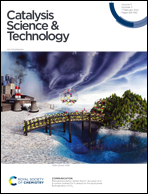Construction and evolution of active palladium species on phase-regulated reducible TiO2 for methane combustion†
Abstract
Active palladium species play a pronounced role in determining the catalytic performance of supported catalysts. Although extensive studies have been made, the variation of palladium species on the surface of reducible supports still needs to be clarified due to the complex metal–support interactions (MSI). Herein, investigations were performed on Pd/TiO2 catalysts, which were tailored by regulating the phase structure of TiO2. The thermal treatment of TiO2 at 1000 °C gave rise to a “snow cookie”-like catalyst structure comprising amorphous surface palladium species and rutile TiO2 supports. The as-prepared catalyst possessed abundant Pd2+ species, Ti3+ ions and adsorbed oxygen species, which meanwhile could facilitate the re-oxidation of Pd0 back to PdO, and thus completely catalyzed the combustion of CH4 to CO2 at as low as 370 °C. However, some Pd2+ would be oxidized into Pd4+ on the working catalyst, and then enter the TiO2 lattice to form PdxTi1−xO2, thus exerting a detrimental effect on the oxygen exchange between bulk TiO2 and surface Pd species. Consequently, the re-oxidation ability was weakened, accompanied by the decrease of active PdO species, resulting in the loss of activity during on-stream tests.



 Please wait while we load your content...
Please wait while we load your content...